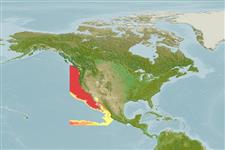>
Gadiformes (Cods) >
Merlucciidae (Merluccid hakes)
Etymology: Merluccius: Latin, mar, maris = the sea + Latin, lucius = pike (Ref. 45335).
More on author: Ayres.
Environment: milieu / climate zone / пределы глубины / distribution range
экология
морской; солоноватоводный pelagic-neritic; пределы глубины 0 - 1000 m (Ref. 9316), usually ? - 229 m (Ref. 2850). Temperate; 51°N - 15°N, 130°W - 77°W (Ref. 58452)
Eastern Pacific: northern Vancouver Island, Canada to northern part of the Gulf of California. A record from the Gulf of Alaska is doubtful.
Length at first maturity / Size / Вес / Возраст
половая зрелость: Lm 37.0, range 34 - 40 cm
Max length : 83.0 cm TL самец/пол неопределен; (Ref. 127973); 105.0 cm TL (female); common length : 60.0 cm TL самец/пол неопределен; (Ref. 1371); наибольший вес (опубликованные данные): 4.2 kg (Ref. 127973); наибольший вес (опубликованные данные): 4.2 kg; наибольший возраст (опубликованны данные): 16 годы (Ref. 56527)
колючие лучи спинного плавника (общее число) : 1; членистые (мягкие) лучи спинного плавника (общее число) : 48 - 56; колючие лучи анального плавника: 0; членистые (мягкие) лучи анального плавника: 40 - 43. Head rather short. Pectoral fin tips usually reaching to or beyond the origin of anal fin. Caudal fin always concave. Color silvery on back grading to whitish ventrally.
Body shape (shape guide): elongated; Cross section: oval.
Inhabit oceanic and coastal areas, but mainly on the continental shelf (Ref. 1371). Although often classified as demersal, the distribution and behavior suggest a largely pelagic existence (Ref. 1371). Adults live in large schools in waters overlying the continental shelf and slope except during the spawning season when they are found several hundred miles seaward (Ref. 1371). A nocturnal feeder (Ref. 6885) that feed on a variety of fishes and invertebrates (Ref. 1371). Important prey for sea lions and small cetaceans (Ref. 2850); also prey of dogfish (Ref. 11384).
Cohen, D.M., T. Inada, T. Iwamoto and N. Scialabba, 1990. FAO species catalogue. Vol. 10. Gadiform fishes of the world (Order Gadiformes). An annotated and illustrated catalogue of cods, hakes, grenadiers and other gadiform fishes known to date. FAO Fish. Synop. 125(10). Rome: FAO. 442 p. (Ref. 1371)
Статус Красного Списка МСОП (Ref. 130435: Version 2025-1)
Угроза для людей
Harmless
Использование человеком
рыболовство: важный объект промысла; объект спортивного рыболовства: да
дополнительная информация
инструменты
Специальные отчеты
Скачать в формате XML
ресурсы в Интернет
Estimates based on models
Preferred temperature (ссылка
123201): 7 - 12.6, mean 8.6 °C (based on 23 cells).
Phylogenetic diversity index (ссылка
82804): PD
50 = 0.5000 [Uniqueness, from 0.5 = low to 2.0 = high].
Bayesian length-weight: a=0.00457 (0.00381 - 0.00549), b=3.10 (3.05 - 3.15), in cm total length, based on LWR estimates for this species (Ref.
93245).
Trophic level (ссылка
69278): 4.4 ±0.0 se; based on diet studies.
устойчивость к внешним воздействиям (ссылка
120179): средний (среднего размера), минимальное время удвоения популяции 1.4-4.4 года (tmax=17; tm=4; also Musick et al. 2000 (Ref.
36717)).
Prior r = 0.52, 95% CL = 0.35 - 0.79, Based on 4 full stock assessments.
Fishing Vulnerability (Ref.
59153): Moderate vulnerability (43 of 100).
🛈
Climate Vulnerability (Ref.
125649): Moderate to high vulnerability (53 of 100).
🛈
Nutrients (Ref.
124155): Calcium = 10.2 [5.9, 23.4] mg/100g; Iron = 0.258 [0.108, 0.535] mg/100g; Protein = 18.1 [17.0, 19.4] %; Omega3 = 0.307 [0.183, 0.505] g/100g; Selenium = 21.6 [9.0, 51.7] μg/100g; VitaminA = 17.2 [5.7, 53.3] μg/100g; Zinc = 0.357 [0.261, 0.491] mg/100g (wet weight); based on
nutrient studies.
